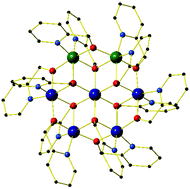当前位置:
X-MOL 学术
›
Dalton Trans.
›
论文详情
Our official English website, www.x-mol.net, welcomes your feedback! (Note: you will need to create a separate account there.)
Order in disorder: solution and solid-state studies of [M III2M II5] wheels (MIII = Cr, Al; MII = Ni, Zn)†‡
Dalton Transactions ( IF 4 ) Pub Date : 2018-03-15 00:00:00 , DOI: 10.1039/c8dt00685g Hector W. L. Fraser 1, 2, 3, 4 , Gary S. Nichol 1, 2, 3, 4 , Dušan Uhrín 1, 2, 3, 4 , Ulla Gro Nielsen 5, 6, 7, 8, 9 , Marco Evangelisti 10, 11, 12, 13 , Jürgen Schnack 14, 15, 16, 17 , Euan K. Brechin 1, 2, 3, 4
Dalton Transactions ( IF 4 ) Pub Date : 2018-03-15 00:00:00 , DOI: 10.1039/c8dt00685g Hector W. L. Fraser 1, 2, 3, 4 , Gary S. Nichol 1, 2, 3, 4 , Dušan Uhrín 1, 2, 3, 4 , Ulla Gro Nielsen 5, 6, 7, 8, 9 , Marco Evangelisti 10, 11, 12, 13 , Jürgen Schnack 14, 15, 16, 17 , Euan K. Brechin 1, 2, 3, 4
Affiliation

|
A family of heterometallic Anderson-type ‘wheels’ of general formula [MIII2MII5(hmp)12](ClO4)4 (where MIII = Cr or Al and MII = Ni or Zn giving [Cr2Ni5] (1), [Cr2Zn5] (2), [Al2Ni5] (3) and [Al2Zn5] (4); hmpH = 2-pyridinemethanol) have been synthesised solvothermally. The metallic skeleton common to all structures describes a centred hexagon with the MIII sites disordered around the outer wheel. The structural disorder has been characterised via single crystal X-ray crystallography, 1–3D 1H and 13C solution-state NMR spectroscopy of the diamagnetic analogue (4), and solid-state 27Al MAS NMR spectroscopy of compounds (3) and (4). Alongside ESI mass spectrometry, these techniques show that structure is retained in solution, and that the disorder is present in both the solution and solid-state. Solid-state dc susceptibility and magnetisation measurements on (2) and (3) reveal the Cr–Cr and Ni–Ni exchange interactions to be JCr–Cr = −1 cm−1 and JNi–Ni,r = −5 cm−1, JNi–Ni,c = 10 cm−1. Fixing these values allows us to extract JCr–Ni,r = −1.2 cm−1, JCr–Ni,c = 2.6 cm−1 for (1), the exchange between adjacent Ni and Cr ions on the ring is antiferromagnetic and between Cr ions on the ring and the central Ni ion is ferromagnetic.
中文翻译:

乱序:[M III 2 M II 5 ]车轮的溶液和固态研究(M III = Cr,Al; M II = Ni,Zn)† •
通式为[M III 2 M II 5(hmp)12 ](ClO 4)4的一类杂金属安德森式“车轮” (其中M III = Cr或Al,M II = Ni或Zn,给出[Cr 2 Ni 5 ](1),[Cr 2 Zn 5 ](2),[Al 2 Ni 5 ](3)和[Al 2 Zn 5 ](4); hmpH = 2-吡啶甲醇)已经溶剂热合成。所有结构共有的金属骨架描绘了一个中心六边形,其中M III位置围绕外轮无序排列。通过单晶X射线晶体学,抗磁性类似物的1–3D 1 H和13 C溶液态NMR光谱(4)以及化合物的固态27 Al MAS NMR光谱(3)来表征结构紊乱。(4)。除了ESI质谱分析法外,这些技术还表明结构保留在溶液中,并且无序现象同时存在于溶液和固态中。(2)和(3)上的固态直流磁化率和磁化强度测量结果表明,Cr-Cr和Ni-Ni交换相互作用为J Cr-Cr = -1 cm -1和J Ni-Ni,r = -5 cm -1,J Ni–Ni,c = 10 cm -1。固定这些值可以使我们提取J Cr–Ni,r = −1.2 cm -1,J Cr–Ni,c = 2.6 cm -1对于(1),环上相邻的Ni和Cr离子之间的交换是反铁磁性的,而环上的Cr离子和中心Ni离子之间的交换是铁磁性的。
更新日期:2018-03-15
中文翻译:

乱序:[M III 2 M II 5 ]车轮的溶液和固态研究(M III = Cr,Al; M II = Ni,Zn)† •
通式为[M III 2 M II 5(hmp)12 ](ClO 4)4的一类杂金属安德森式“车轮” (其中M III = Cr或Al,M II = Ni或Zn,给出[Cr 2 Ni 5 ](1),[Cr 2 Zn 5 ](2),[Al 2 Ni 5 ](3)和[Al 2 Zn 5 ](4); hmpH = 2-吡啶甲醇)已经溶剂热合成。所有结构共有的金属骨架描绘了一个中心六边形,其中M III位置围绕外轮无序排列。通过单晶X射线晶体学,抗磁性类似物的1–3D 1 H和13 C溶液态NMR光谱(4)以及化合物的固态27 Al MAS NMR光谱(3)来表征结构紊乱。(4)。除了ESI质谱分析法外,这些技术还表明结构保留在溶液中,并且无序现象同时存在于溶液和固态中。(2)和(3)上的固态直流磁化率和磁化强度测量结果表明,Cr-Cr和Ni-Ni交换相互作用为J Cr-Cr = -1 cm -1和J Ni-Ni,r = -5 cm -1,J Ni–Ni,c = 10 cm -1。固定这些值可以使我们提取J Cr–Ni,r = −1.2 cm -1,J Cr–Ni,c = 2.6 cm -1对于(1),环上相邻的Ni和Cr离子之间的交换是反铁磁性的,而环上的Cr离子和中心Ni离子之间的交换是铁磁性的。



























 京公网安备 11010802027423号
京公网安备 11010802027423号